Dog Grooming - How to guide
Dog grooming is very important in keeping your pet clean and healthy. Some people mistaken grooming with just “brushing and combing”, but dog grooming includes also bathing, cleaning the eyes, ears and teeth, as well as nail trimming. Learn how to groom your dog so you don’t have to spend a fortune at dog groomers. Read the following guide to learn how to groom a dog. You may also want to look for dog grooming courses in your neighborhood to get first-hand experience in dog grooming.
| Dog Grooming - How to Guide |
|---|
How much to groom
How much grooming your dog needs depend on his coat type. Short-haired dogs only need weekly brushing while medium and long coated dogs are prone to matting and should be groomed daily. The purpose of brushing and combing is to remove dead hair, distribute oils, and hasten shedding. Ungroomed hair can quickly become tangled and will need to be shaved to prevent bacterial infection between the hair and the skin.
Long coated or double coated dogs: These dogs have high grooming needs. If you have one of the following breeds, you will need to do a good amount of brushing and combing every day. Keep your dog flea and tick-free by shampooing regularly and clipping his fur every two months. Airedale Terrier, Australian Terrier, Bichon Frise, Border Collie, Chow Chow, Cocker Spaniel, English Sheepdog, Irish Water Spaniel, Kerry Blue Terrier, Komondor, Maltese, Newfoundland, Pekingese, Pomeranian, Poodle, Portuguese Water Dog, Saint Bernard, Samoyed, Schipperke, Schnauzer, Scottish Terrier, Shih Tzu, Soft Coated Wheaten Terrier and Yorkshire Terrier. If you are unsure what you need do, learn from professional dog groomers or sign up to dog grooming courses.
Short coated dogs: These dog breeds have relatively lower grooming requirements. Brushing should be done once or twice a week. Eyes and ears should be cleaned regularly to prevent infection. Nails need to be trimmed once they reach the ground and teeth should be brushed daily. Akita, Australian Cattle Dog, Australia Terrier, Beagle, Bloodhound, Boxer, Bulldog, Chihuahua, Dalmatian, Doberman, German Shepherd, Great Dane, Greyhound, Labrador Retriever, Mastiff, Pug, Rottweiler, Shiba Inu and Weimaraner. Read the rest of the guide to learn how to groom your dog.
Start with puppies
Start grooming your dog when he is a puppy. Teach him basic commands so you can ask your dog to sit, stand or lie down while you groom him. Make it into a habit that he looks forward to by grooming him the same time everyday and offering your dog treats after having combed and brushed his hair. Animals in the wild, including monkeys, wolves and lions, groom each other as part of the social interaction of the pack. Dog are born with the same instincts so grooming provides good bonding time for you and your dog.
How to use all these tools
Depending on your dog’s grooming needs, you toolbox should contain some or all of the following tools: brush, comb, rake, dematter, and deshedder.
Brush: One of the 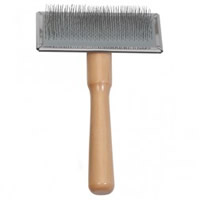 key tools to dog grooming. You can choose between metal, bubble tip or plastic for different hardness. Generally the heavier the coat, the harder the brush required. Get a plastic brush or one with bubble tip if you are inexperienced and are concerned about hurting your dog. Otherwise, metal brushes like slicker brushes are most effective in smoothing the coat and taking out mats and tangles. Other common brushes used for dog grooming are bristle brush (dense bristle), wire pin brush (long metal bristles) and curry brush (short teeth – get a plastic or rubber one). Go to my dog products page to learn about and view picture of each brush.
key tools to dog grooming. You can choose between metal, bubble tip or plastic for different hardness. Generally the heavier the coat, the harder the brush required. Get a plastic brush or one with bubble tip if you are inexperienced and are concerned about hurting your dog. Otherwise, metal brushes like slicker brushes are most effective in smoothing the coat and taking out mats and tangles. Other common brushes used for dog grooming are bristle brush (dense bristle), wire pin brush (long metal bristles) and curry brush (short teeth – get a plastic or rubber one). Go to my dog products page to learn about and view picture of each brush.
Comb: You don’t need to be a professional dog groomer to use one of these. The comb usually com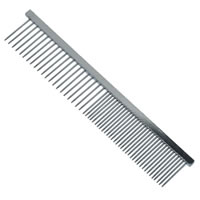 eswith an end with coarse teeth and another end with fine teeth. The different widths are designed for different types of dog coats. The comb can be useful in areas that are common for knots, like the arm pits which may be difficult to untangle with a brush. The brush and comb are the most basic tools for dog grooming and are essential for all types of dogs.
eswith an end with coarse teeth and another end with fine teeth. The different widths are designed for different types of dog coats. The comb can be useful in areas that are common for knots, like the arm pits which may be difficult to untangle with a brush. The brush and comb are the most basic tools for dog grooming and are essential for all types of dogs.
Rake: An important grooming tool for double-coated dogs. Double coated dog breeds have a layer of protective overcoat covering a softer layer of undercoat. The rake is used to remove loose hair from the dog’s undercoat. Similar to a hay rake, they have lo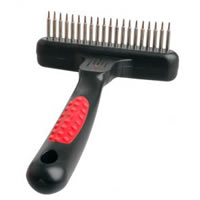 ng teeth that are designed to penetrate down to remove loose hair and hasten shedding. Dogs grow heavy coats in the water to insulate against the cold and shed these extra hair in the summer. Grooming using a rake facilitates the shedding process by removing loose hair and hastening shedding. This can help prevent a dog from shedding everywhere in the house and helps the dog keep cool in the summer. The rake can also be used for untangling and dematting. It is a common misconception that dogs that shed require more raking. Poodles, which don’t shed much, also require frequent raking to maintain a healthy coat. Ask a professional dog groomer how often you should rake your dog.
ng teeth that are designed to penetrate down to remove loose hair and hasten shedding. Dogs grow heavy coats in the water to insulate against the cold and shed these extra hair in the summer. Grooming using a rake facilitates the shedding process by removing loose hair and hastening shedding. This can help prevent a dog from shedding everywhere in the house and helps the dog keep cool in the summer. The rake can also be used for untangling and dematting. It is a common misconception that dogs that shed require more raking. Poodles, which don’t shed much, also require frequent raking to maintain a healthy coat. Ask a professional dog groomer how often you should rake your dog.
Dematting Tools: Mats are clumps of knotted fur that can lead to skin irritations and can be painful for dogs. You should be able to untangle mats before they become a problem if you groom your dog regularly. Simple mats can be unknotted with metal combs or slicker brushes. For tougher mats, try using a detangling spray – which lubricates and loosens mats, or a dematting rake (which is just another rake with a single purpose). The dematting rake is an intimidating tool dog groomers use to cut through stubborn mats that regular dog combs can’t get through. Gently guide the dematting rake on your dog’s mat to remove clumps of fur without hurting your dog.
Deshedder / Deshedding Tools: These are tools designed especially to remove loose hair from the undercoat. Functionality-wise, deshedders are similar to the rake. But some users find deshedding tools, like FURminator, more effective in removing dead hair. You should think about getting a deshedding tool if you own one of these double coated dogs: Siberian Husky, Samoyed, Collie, Newfoundland, Saint Bernard, Pomeranian, German Shepherd or American Eskimo.
Bathing your Dog
Bathing helps keep your dog’s coat and skin healthy but you shouldn’t bath your dog too often because it can remove the natural oil off his skin. The loss of these oils can make the dog’s skin irritating, leading to scratching and potential infection. This is especially true for thick coated breeds like Chow Chow and Husky which needs natural oil in their undercoat to keep their fur healthy.
In general, you can bath your dog when he starts having that doggy odor, which should be about once a month depending on his activity level. Some people may choose to bath their dog more than once a month because their dog lives outdoor or the area they live in is hot and humid. For dogs that require more than one bath a month, you can use oatmeal based or aloe based shampoos that don’t dry their natural oil as much and supplement their diets with omega fatty acids which aid skin regeneration. Remember never to use human shampoo or conditioner on your dog because a dog’s skin has a different pH level than human.
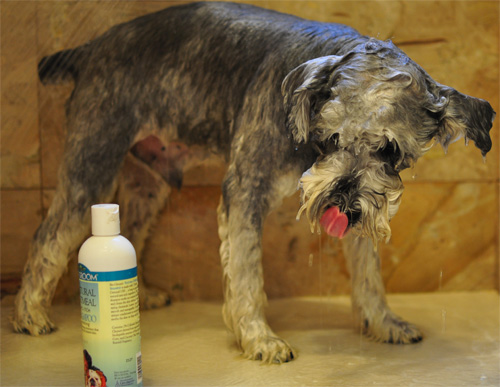
The process of bathing a dog is fairly simple. Before bathing, use your grooming tools to clear any mats or tangles from the dog’s coat, these will be a lot harder to deal with if the fur is wet. Once your dog is free of mats and tangles bring him into the bathtub and ask him to stay as you add warm water to the tub. When you have enough water, apply and massage shampoo on your dog’s skin while taking care to avoid his eyes and ears. Rinse thoroughly with warm water until there are no more bubbles on your dog. Repeat this step with a conditioner if you want your dog to have silky smooth fur. When you are done bathing your dog and have rinsed off all shampoo and conditioner, dry your dog by wrapping him in a towel and blot up as much water as you can with the bath towels.
Gently rub cotton balls in your dog’s ears to dry off excess water. Finally, use a hair dryer under a low heat setting to finish drying your dog off. Keep in mind most dogs hate the hair dryer because it is hot and noisy, so make sure you give your dog a tasty reward after everything is done so he learns getting a bath is not a frightening experience.
How to clean your dog’s eyes and ears?
To clean a dog’s ears, soak a cotton ball thoroughly with dog ear wash and rub gently in your dog’s ear. The cotton ball should be wet enough to get the job done but not so wet that it drips down your dog’s ear canal. Let your dog shake off any excess moisture and repeat with the other ear.
Keep your dog’s eyes clean to reduce the risk of eye infection. You can do this by keeping your dog away from dusty areas and places with excessive debris in the air and trim your dog’s fur if it gets into his eyes. Be on the notice for unusual amount of discharge around your dog’s eyes. There is a good chance your dog has eye infection if large amount of discharge is accompanied by redness, cloudiness or inflammation of the eye. Bring your dog to see the veterinarian as soon as possible if any of these symptoms are present. Do not try to resolve any eye problems without first consulting a veterinarian.
Nail trimming your dog
Spend a little money to buy a good nail clipper and nail file that has a sharp precise cut and don’t rust after washing. As with other parts of dog grooming, start trimming your dog’s nails at a young age so he gets ac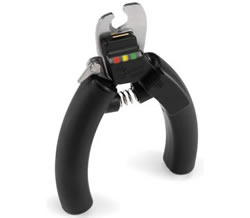 customed to it. Get a lesson from a professional dog groomer or your veterinarian about dog trimming and see how it is done in person. You don’t want to experiment this for yourself because you can seriously hurt your dog if you cut too deeply into his quick.
customed to it. Get a lesson from a professional dog groomer or your veterinarian about dog trimming and see how it is done in person. You don’t want to experiment this for yourself because you can seriously hurt your dog if you cut too deeply into his quick.
A dog’s nail made of a hard protective outer layer and an inner part containing blood vessels and nerve endings called the quick. The goal of nail trimming is to clip off some of the hard layer without damaging the inner part. The quick is visibly pink in dogs with light colored nails but much harder to see in dogs with black nails.
 Trim your dog’s nails when they are long enough to make a click against the floor. Start at the tip of the nail and clip a little at a time. Stop when you see pale pink tissue near the top of the cut edge and use a nail file to smooth the edges. Trim smaller bits if your dog has black nail and the quick is totally invisible. Look out for a dark spot in the middle of the clipped area, which is the start of the quick, and do not cut too far into this. Cutting into the quick causes profuse bleeding. If the nail begins to bleed, apply pressure using styptic powder or a substitute such as baby powder or corn powder. Also, don’t forget the dew claw that is hidden on the back of your dog’s leg.
Trim your dog’s nails when they are long enough to make a click against the floor. Start at the tip of the nail and clip a little at a time. Stop when you see pale pink tissue near the top of the cut edge and use a nail file to smooth the edges. Trim smaller bits if your dog has black nail and the quick is totally invisible. Look out for a dark spot in the middle of the clipped area, which is the start of the quick, and do not cut too far into this. Cutting into the quick causes profuse bleeding. If the nail begins to bleed, apply pressure using styptic powder or a substitute such as baby powder or corn powder. Also, don’t forget the dew claw that is hidden on the back of your dog’s leg.
Dental care for dogs
Giving your dog appropriate dental care can help prevent a lot of common diseases. Keep your dog’s teeth clean and healthy by feeding a dry crunchy diet, teeth cleaning toys and daily tooth brushing.
Use toothbrushes designed for dogs or finger toothbrushes that slip on your finger and remember to 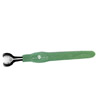 only use toothpaste made for dogs. You want to start by giving your dog a taste of the toothpaste for a few days. If your dog clearly does not like the taste, you may need to try a different flavor. The next step is to have your dog become comfortable with something brushing against his teeth. Apply toothpaste to your finger and gently rub it on his teeth. Praise your dog and continue for another several days. You can start your daily tooth brushing routine once your dog is used to both the toothpaste and toothbrush. Make it a mission to brush your dog’s teeth everyday to remove plague and prevent tartar formation.
only use toothpaste made for dogs. You want to start by giving your dog a taste of the toothpaste for a few days. If your dog clearly does not like the taste, you may need to try a different flavor. The next step is to have your dog become comfortable with something brushing against his teeth. Apply toothpaste to your finger and gently rub it on his teeth. Praise your dog and continue for another several days. You can start your daily tooth brushing routine once your dog is used to both the toothpaste and toothbrush. Make it a mission to brush your dog’s teeth everyday to remove plague and prevent tartar formation.
